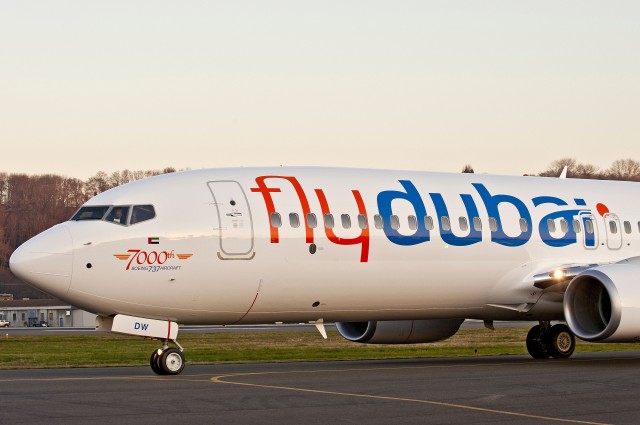
HI-RES PHOTO (click for larger). On December 16th, Boeing delivered their 7000th 737 to flydubai. The airplane is flydubai’s 14th Next-Generation 737-800 with the new Boeing Sky Interior. Photo by Boeing.
On Friday I posed the question, “How many Boeing 737s are still flying today,” and I received a lot of responses. So what is the answer? (insert drum roll here)…
… did you click that drum roll link? It really adds to the suspense. If you did not do it before, it is not too late…
According to Boeing, there are 5,424 737s still flying today with 358 airlines in 114 countries. Knowing that the first 737 flew on April 9, 1967, that is AMAZING! So, who were the three that got the closest and are winning a free internet session with GoGo In-Flight Internet?
* Thibaut: 5418
* Allen Cheng: 5419
* Will Pestle 5423 (only one away)
Some of you just guessed random numbers (which works out okay) and others went through some pretty impressive formulas. I was amazing how many people were pretty close to the final answers. A big thanks go GoGo for providing three prizes for this contest!
As promised, here are some other great facts about the 737 that come directly from Boeing:
* Today’s 737s are 5 percent more fuel efficient than the first models delivered. By late-2012, the airplanes will be a full 7 percent more efficient, with full incorporation of the latest performance improvement package. The additional 2 percent equates to $120,000 savings per airplane per year, and tons fewer carbon emissions.
* It was just shy of 15 years between the first Next-Generation 737 order and the 5,000th order. The Next-Generation 737 reached this order milestone more quickly than any other commercial jet in history.
* Airlines ordered 724 of the Next-Generation 737 models between the Next-Generation program launch Nov. 17, 1993, and the day the first airplane was delivered on Dec. 12, 1997.
* The Next-Generation 737 is as long as it is wide, earning it the nickname of the first ’œsquare’ airplane.
* The Next-Generation 737 uses an advanced system called Head-up Display or HUD, which comprises a transparent glass display positioned between the pilot’s eye and flight deck window to show critical information such as airspeed, altitude and attitude, and flight path. The Next-Generation 737 is the leader of large commercial jetliners produced today with this capability. Boeing is proud to introduce HUD as part of its basic systems equipment for both pilots on our 787.
* The Next-Generation 737 airplane wing thermal anti-ice system has the capability of outputting hot air on the wing leading edge equivalent to about six full-sized (100,000 BTU) household furnaces.
* Within five years of entering service, the worldwide fleet of Next-Generation 737s surpassed 10 million flight hours, a feat equal to one airplane flying more than 1,141 years nonstop. The Next-Generation 737 is the first and only commercial jetliner to reach this milestone so quickly.
* On July 27, 2006, Boeing delivered the 2,000th Next-Generation 737 six years sooner than any other commercial jet airplane. The milestone delivery ’“ a 737-700 to Southwest Airlines ’“ occurred nine years after Southwest received the first Next-Generation 737.
* There are approximately 36.6 miles (59 kilometers) of wire on the Next-Generation 737-600/-700/-800/-900ER (extended range) models, four miles (6.4 kilometers) less than the 737-300/-400/-500 models.
* On average, there are approximately 367,000 parts on a Next-Generation 737 airplane.
* Overall, the entire 737 family is the best-selling commercial jet in history, with orders for more than 9,100 airplanes through the end of November 2011. More than 6,900 have been delivered.
* On Feb. 13, 2006, Boeing delivered the 5,000th 737 to Southwest Airlines. Guinness World Records acknowledged the 737 as the most-produced large commercial jet airplane in aviation history.
* Typically, about 50 gallons (189 liters) of paint are used to paint an average 737. Once the paint is dry, it will weigh approximately 250 pounds (113 kilograms) per airplane, depending on the paint scheme.
David, the 737 could possibly pass the DC-3s all-time production record for a transport aircraft. I think over 10,000 “threes” were built, and given the 737’s longevity and popularity, that might be a possibility. Did Boeing give you a breakdown by variant of the ones still flying? (I was off by 114)
There were 16,079 DC-3s built, so the 737 has a long way to go, and I doubt it will ever make it there.
Kris, technically you are correct, but the total of 16,079 includes the 4,937 Li-2s produced in the Soviet Union and the 487 L2D2s built in Japan during World War II. Nothing similar relates to the 737. Take away those foreign “license-built” versions (most of which Douglas never received a royalty) and the DC-3 production stands at 10,655, which could be matched by the 737.
I see that over 1500 737s of the 7000 built are no longer flying.
The equivalent numbers of the A320 family for the end of November show that only 97 of the 4903 built were out of service.
(The 7000 airplanes that Airbus delivered by December included several other models – see the table at
http://www.airbus.com/presscentre/corporate-information/orders-deliveries/ )
You also have to remember that the A320 has only been in service since March 1988, where the 737 has been in service since February 1968.
David
Not really a fair comparison since the first flight of an A320 was in 1987, the 737 first flew in 1967.